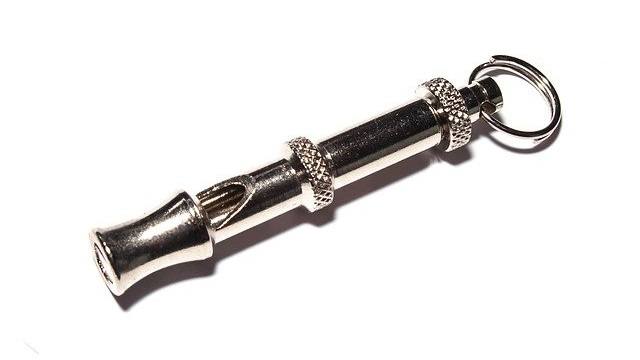Let’s clean the dust from 1876’s old Inquiries into Human Faculty and its Development, just to thank Francis Galton for this curious invention! In sum, the book talks about the tests Francis Galton performed using the dog whistle he invented. He concluded that its ultrasounds were not audible to people, and yet… his domestic cat had some reactions to the quiet hissing sound! So, you might be wondering about a lot of topics: do you need one of these? How can you use it for dog training? And are its sounds harmful to dogs in any way? Well, come and take the tour!
📊 What about some nerd facts first? Check the ultrasound range (in kilohertz) in which people and animals can hear:
- Middle-aged adults: between 15-17 kHz frequencies.
- Children: up to 20 kHz.
- Cats: up to 64 kHz.
- Dogs: up to 45 kHz.
- Dog whistle: between 23-54 kHz frequencies, although some may be adjusted to our hearing range.
Choosing The Best Dog Whistle

Do you need a dog whistle?
Let’s be honest: they can be fun, in a way – who doesn’t find it funny when your dog’s ears are up and they start turning their neck searching for the origin of the sound? ? However, they’re not a primary necessity for most pet parents, unless they just cannot stand the annoying sound of the common whistle! On the other hand, if you live in a farm, you can train your shepherd dog and teach them some herding maneuvers through different “whistle codes”.
This was mainly why the dog whistle was invented! Long before Galton’s idea, shepherds whistled to their fluffy sheepdogs using their hands (or just their mouths). Nowadays, in some rural European areas, they use a flat metal whistle, which emits a distinctive sound – the “modern” dog whistle.
Last but not least, some electronic whistles are also used to determine the hearing range for people, as well as for physical demonstrations. Are you Heinrich Hertz? 🧐
What features does the “purrfect” dog whistle include?
Alright, alright! If you still have the whistle in your mind, here’s what you should look for:
- Easily replaceable – be sure you’re able to buy a second whistle with the exact same sound – otherwise, your dog won’t be used to the sound of the new one in case you lose the first.
- Consistent sound – if you blow the whistle a couple of times, the sound should always be the same.
- Volume range – the whistle should be dog-audible within a 200-yards range.
- Sturdy material – as they’re meant to be used outdoors, be sure they won’t break if they fall to the ground.
- Washable – remember you’ll regularly put your mouth on it!
Pros & Cons of Dog Whistles

Still undecided about whether or not you should buy a dog whistle? Maybe it’s better if you analyze the pros and cons before you make your final decision! In any case, don’t forget that they should be used with moderation, as you may conclude by reading the bullets below.
Pros
- Dog whistle training is pretty effective, especially to teach our buddies to be obedient – “oh, my parent has blown the whistle so I must stop”!
- Due to their characteristic sound, they can also be used to call your dog back when they’re too far away.
- As the sound is distinctive, only your dog will react to the whistle.
- The dog whistle sound is “weatherproof”, while human voice is not… Ready to call your pooch in a snowy Winter evening?
- Obviously, dog whistles are very useful in dog training classes, as dogs have the ability to associate specific sound codes to the parent’s desired commands.
Cons
- You’ve blown the whistle, but your dog did not react? That’s not a very weird situation, as the effectiveness varies from dog to dog. Anyway, try the whistle with other dogs, just to be sure the problem doesn’t come from it.
- An abusive usage of this training tool will obviously make it lose effectiveness over time.
- If your dog is fearful and they start to associate the whistle sound to a strict command, they’ll be even more afraid of it. This may result in traumas, also known as “poisoned commands”.
- Most dog whistles are not harmful, but don’t forget your four-legged friend has a much more sensitive and powerful hearing than you. If you “overblow” the whistle, you can be inflicting them some discomfort.
How To Train Your Pooch Using A Dog Whistle

As you can see, dog whistle training has much to do with sound codes and the corresponding command! Just like dog treats, whistles can have a Pavlovian effect on your buddy, showing them what’s good and bad behavior. (Try to) listen to some of the sounds below with your dog nearby and check if there’s any effect on them! 🐶
PS: don’t forget your computer / smart device may not process all the sounds properly…
Dog whistle frequency
First things first: listen to eight different frequencies of dog whistle sounds.
Loud dog whistle
Please do not abuse this one, or you may be inflicting your dog some pain! Anyway, see if they react to the sound.
“Stop barking” sound
Wondering if dog whistles make dogs stop barking? Well, they’ll at least stop barking out loud when they hear this sound!
Conclusion
We hope you’ve enjoyed this journey, and learned How has your dog reacted to these sounds? Share your experience in the comments!
Maven is all about proactive pet care. Be your best friend’s best friend by giving them 24/7, high-quality, industry-leading vet care to improve their mental health, physical health and more. No more frantic googling or unneeded stressful visits to the vet – Maven helps you save hundreds while also ensuring your pet lives the best life possible. Get your kit now!




Interesting stuff! Gonna test those audio clips on my dog to see if/how he reacts
I bought a dog whistle but my dog hasn’t reacted to it at all, good to know it varies from dog to dog as I was wondering what the issue was
Always wondered how these worked